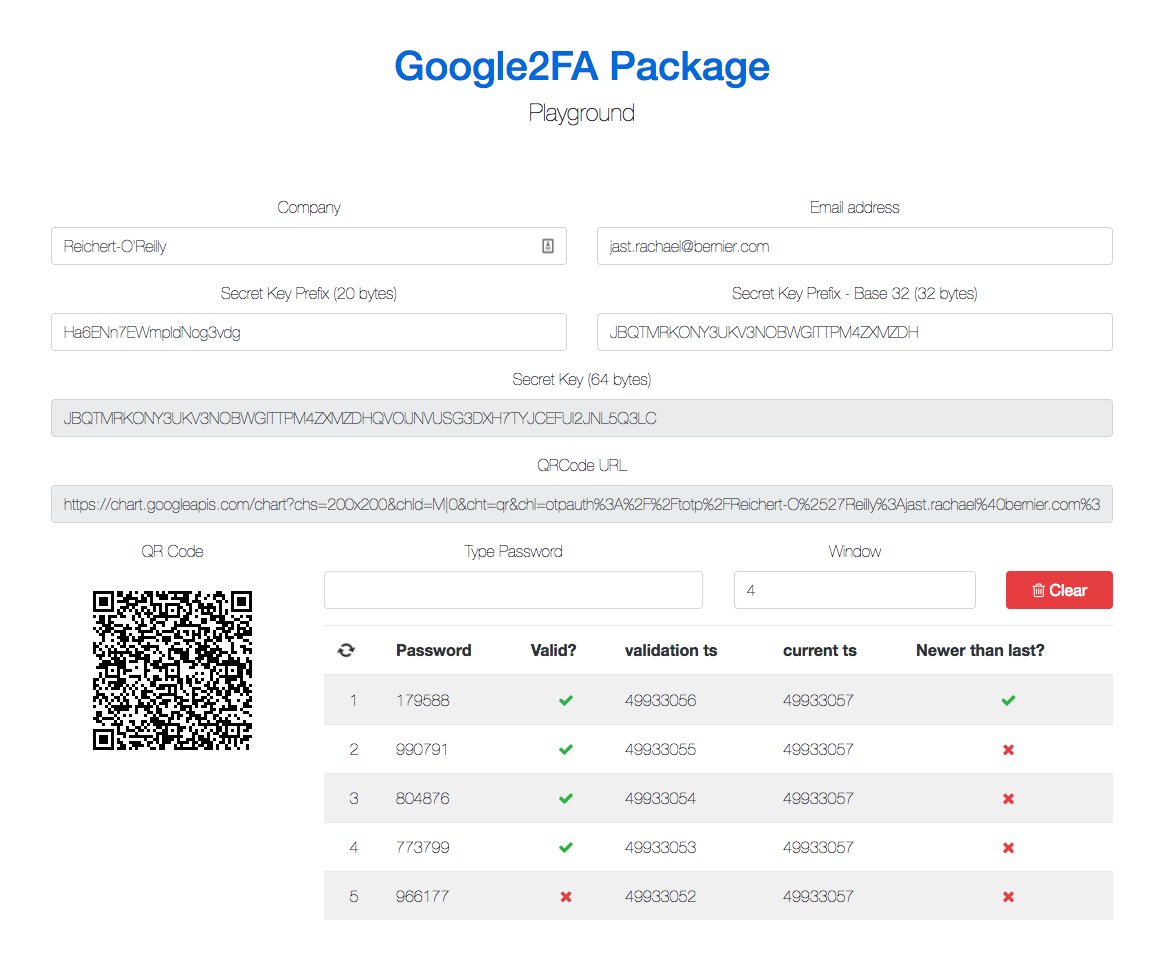Google2FA is a PHP implementation of the Google Two-Factor Authentication Module, supporting the HMAC-Based One-time Password (HOTP) algorithm specified in RFC 4226 and the Time-based One-time Password (TOTP) algorithm specified in RFC 6238.
This package is agnostic, but there's a Laravel bridge.
Please check the Google2FA Package Playground.
Here's an demo app showing how to use Google2FA: google2fa-example.
You can scan the QR code on this (old) demo page with a Google Authenticator app and view the code changing (almost) in real time.
- PHP 5.4+
Use Composer to install it:
composer require pragmarx/google2fa
If you prefer inline QRCodes instead of a Google generated url, you'll need to install BaconQrCode:
composer require bacon/bacon-qr-code
use PragmaRX\Google2FA\Google2FA;
$google2fa = new Google2FA();
return $google2fa->generateSecretKey();Generate a secret key for your user and save it:
$user->google2fa_secret = $google2fa->generateSecretKey();The securer way of creating QRCode is to do it yourself or using a library. First you have to install the BaconQrCode package, as stated above, then you just have to generate the inline string using:
$inlineUrl = $google2fa->getQRCodeInline(
$companyName,
$companyEmail,
$secretKey
);And use it in your blade template this way:
<img src="{{ $inlineUrl }}">$secretKey = $google2fa->generateSecretKey(16, $userId);It's insecure to use it via Google Apis, so you have to enable it before using it.
$google2fa->setAllowInsecureCallToGoogleApis(true);
$google2fa_url = $google2fa->getQRCodeGoogleUrl(
'YourCompany',
$user->email,
$user->google2fa_secret
);
/// and in your view:
<img src="{{ $google2fa_url }}" alt="">And they should see and scan the QR code to their applications:
And to verify, you just have to:
$secret = $request->input('secret');
$valid = $google2fa->verifyKey($user->google2fa_secret, $secret);This package suggests the use of Bacon/QRCode because it is known as a good QR Code package, but you can use it with any other package, for instance Simple QrCode, which uses Bacon/QRCode to produce QR Codes.
Usually you'll need a 2FA URL, so you just have to use the URL generator:
$google2fa->getQRCodeUrl($companyName, $companyEmail, $secretKey)Here's an example using Simple QrCode:
<div class="visible-print text-center">
{!! QrCode::size(100)->generate($google2fa->getQRCodeUrl($companyName, $companyEmail, $secretKey)); !!}
<p>Scan me to return to the original page.</p>
</div>It's really important that you keep your server time in sync with some NTP server, on Ubuntu you can add this to the crontab:
sudo service ntp stop
sudo ntpd -gq
sudo service ntp start
To avoid problems with clocks that are slightly out of sync, we do not check against the current key only but also consider $window keys each from the past and future. You can pass $window as optional third parameter to verifyKey, it defaults to 4. A new key is generated every 30 seconds, so this window includes keys from the previous two and next two minutes.
$secret = $request->input('secret');
$window = 8; // 8 keys (respectively 4 minutes) past and future
$valid = $google2fa->verifyKey($user->google2fa_secret, $secret, $window);An attacker might be able to watch the user entering his credentials and one time key.
Without further precautions, the key remains valid until it is no longer within the window of the server time. In order to prevent usage of a one time key that has already been used, you can utilize the verifyKeyNewer function.
$secret = $request->input('secret');
$timestamp = $google2fa->verifyKeyNewer($user->google2fa_secret, $secret, $user->google2fa_ts);
if ($timestamp !== false) {
$user->update(['google2fa_ts' => $timestamp]);
// successful
} else {
// failed
}Note that $timestamp either false (if the key is invalid or has been used before) or the provided key's unix timestamp divided by the key regeneration period of 30 seconds.
Although the probability of collision of a 16 bytes (128 bits) random string is very low, you can harden it by:
$secretKey = $google2fa->generateSecretKey(32); // defaults to 16 bytesYou may prefix your secret keys, but you have to understand that, as your secret key must have length in power of 2, your prefix will have to have a complementary size. So if your key is 16 bytes long, if you add a prefix it must be also 16 bytes long, but as your prefixes will be converted to base 32, the max length of your prefix is 10 bytes. So, those are the sizes you can use in your prefixes:
1, 2, 5, 10, 20, 40, 80...
And it can be used like so:
$prefix = strpad($userId, 10, 'X');
$secretKey = $google2fa->generateSecretKey(16, $prefix);The Window property defines how long a OTP will work, or how many cycles it will last. A key has a 30 seconds cycle, setting the window to 0 will make the key lasts for those 30 seconds, setting it to 2 will make it last for 120 seconds. This is how you set the window:
$secretKey = $google2fa->setWindow(4);But you can also set the window while checking the key. If you need to set a window of 4 during key verification, this is how you do:
$isValid = $google2fa->verifyKey($seed, $key, 4);You can change key regeneration interval, which defaults to 30 seconds, but remember that this is a default value on most authentication apps, like Google Authenticator, which will, basically, make your app out of sync with them.
$google2fa->setKeyRegeneration(40);To be compatible with Google Authenticator, your (converted to base 32) secret key length must be at least 8 chars and be a power of 2: 8, 16, 32, 64...
So, to prevent errors, you can do something like this while generating it:
$secretKey = '123456789';
$secretKey = str_pad($secretKey, pow(2,ceil(log(strlen($secretKey),2))), 'X');And it will generate
123456789XXXXXXX
By default, this package will enforce compatibility, but, if Google Authenticator is not a target, you can disable it by doing
$google2fa->setEnforceGoogleAuthenticatorCompatibility(false);To use the two factor authentication, your user will have to install a Google Authenticator compatible app, those are some of the currently available:
- Authy for iOS, Android, Chrome, OS X
- FreeOTP for iOS, Android and Pebble
- Google Authenticator for iOS
- Google Authenticator for Android
- Google Authenticator (port) on Windows Store
- Microsoft Authenticator for Windows Phone
- LastPass Authenticator for iOS, Android, OS X, Windows
- 1Password for iOS, Android, OS X, Windows
The package tests were written with phpspec.
Google2FA is licensed under the MIT License - see the LICENSE file for details.
Pull requests and issues are more than welcome.







